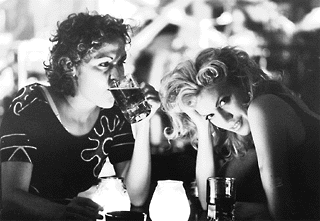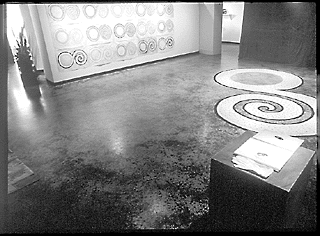Exhibitionism
Fri., June 6, 1997
Savage in Limbo: Balls in Search of a Cue
Hole in the Wall,
June 7 & 8, June 21-July 6

Consider the cue ball. It's different from the other balls used in the game of pool: It is the only pure white ball and the only one that bears no number. And when the balls are put in place for a game, it's set off by itself, separated from the rest. There it stays until it is put in motion by an outside force. If that never happens, the cue ball can never connect with another ball, can never know the touch of one like it the way the other balls on the table do. Denise Savage knows just what that's like; she's 32 years old and feels like a cue ball in the game of life.
When we meet her in this comic drama by John Patrick Shanley, Savage is anxiously drinking away another bleak Monday night in a long string of such nights in a Bronx watering hole. She is desperate to make a change in her life but feels that she can't without help from an outside force. Enter Linda, another 32-year-old Bronx princess ripe for change. The two are as different as wine and beer -- Savage is a fierce thinker with next to no experience in physical pleasure; Linda is no Einstein, but she has a Ph.D. in lovemaking -- yet they're ready to throw in their lot together, to find a way out of their parents' homes and their own loveless lives. Their plan is interrupted, though, when Linda's boyfriend walks into the bar. Once they see Tony -- who's 32, too, and in that same desperate state -- the two women turn to him, fighting to be the catalyst for the change he seeks, to have him be the force that finally moves them.
At times, this production by Shirk Workers Union -- a theatre company that just moved to Austin from Houston -- runs like a crisp game of pool, going from moment to moment with purpose and dead aim, the dramatic conflicts sounding with sharp cracks. The five actors know this emotional territory and sidle around it with the surety of hustlers circling a table. When they're in rhythm, the production sails along. Occasionally, however, they fall out of rhythm. Sometimes it has to do with the environmental setting; they're performing in a real bar and at times, despite their efforts to control access to the space, the life of the bar intrudes upon the fiction and disrupts the show's momentum. Sometimes it's the players themselves, stumbling on a cue or being so focused on their own work that they lose touch with the ensemble. Vicky Weathersby strives mightily to create a Linda who defies the predictable image of a bimbo -- and in many ways succeeds; she's hungrier, edgier than you'd think, and cautious. But Weathersby's repeated reaches for the unconventional line reading, the odd pause, periodically call attention to themselves and throw the piece off-kilter.
But then there's always that cue ball. The show consistently communicates that sense of aloneness, of being unlike all others, without number or color, and apart from the rest. It comes through in Anna Krejci's driven, anxious Savage, a chewed nail of a human being whose ache is as solid and fragile as glass; in Electric Liebracht's aggressive, jumpy Tony, who's on fire with feelings for which he has no words; in Amalia Stifter's foggy, forlorn April, who looks far too healthy for a barfly but is believably lost and sad; in Weathersby's burned and burning Linda, a flame in her eyes; even in Ivan Klousia's barkeep Murk, who breaks his stoic front to calm a frantic April with a visit from Santa, his face desperate to please her. We see them and we're on that carpet of green felt, so far from everyone else and so eager to connect.
-- Robert Faires
Curandart: Seeing Through the Jagaur's Eye
Women & Their Works Gallery
through July 1

Regina Vater's signature installation work -- her "visual poetry" -- is rife with complexities, both on the surface and between the lines. Her latest exhibit is a continuation of her search for wisdom and her efforts to imbue society with it.
Vater takes her work -- and art in general -- very seriously, believing it to be a "powerful tool to heal society" and an agent for creating hope. Her installations have deep roots in these beliefs, and with this latest installation, as with most of her work, Vater's message is subliminally imbedded in physical elements that are so fascinating to stare at that one almost forgets that a spiritual message is their raison d'être.
The central figure of "CurandArt," VerVê, is hard to miss; it cuts a striking swash across the floor like a stylized figure eight left by an ice skater carrying a torn bag of groceries. It's composed of an outer lining of black beans, a narrow inner lining of white rice, and a brilliant wide band of golden corn kernels cutting through the center. One end is a near perfect circle, broken at one point, opening to a trail that follows a beautiful curve with the same dimensions of the circle, spiraling inside itself and ending in a perfectly pointed tip. Inspired by African and Navajo ground paintings and Tibetan sand paintings, the figure symbolizes a jaguar's eye, representing "clarity of vision," and the universal symbol of the spiral, referring to the "ascending and descending journey of the soul." For Vater, the jaguar exemplifies the lucid perception a society needs in order to reach a greater state of awareness. The beans, corn, and rice are the staple foods of the Americas, contextually representing the installation as part of the earth.
These meanings are not apparent on the surface, of course; you would know none of this without reading Vater's descriptions and explanations. But even formulating your own interpretation of the image can be spiritually uplifting. VerVê's curves and colors and its demanding presence in the room act as a narcotic on the senses -- at once entrancing and shocking. My first impression of the work was that of a miniature, majestic yellow brick road; a swirling path that could take you wherever you'd like to go.
Facing the installation is a wall lined with The Jaguar Mantra, 15 drawings, each depicting the VerVê figure with different textures and media, including glitter, acrylic paint, and handmade paper. When positioned together, the drawings begin to look like a pack of jaguars, stoic yet intent, their piercing eyes seeing all that transpires in the room. Vater's accompanying book EyE opEnEr further illuminates her deep interest in the beguiling jaguar, describing its ability to see in darkness, and a shaman's ability to procure that quality in order to illuminate the darkness in people's minds -- much as Vater seeks to do with her artwork.
-- Cari Marshall








